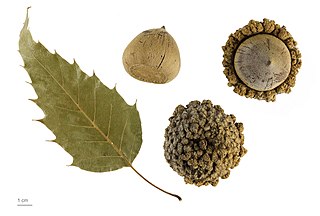
The Sierra Madre Occidental pine–oak forests are a Temperate broadleaf and mixed forests ecoregion of the Sierra Madre Occidental range from the southwest USA region to the western part of Mexico. They are home to a large number of endemic plants and important habitat for wildlife.
Magnolia iltisiana is a species of plant in the family Magnoliaceae. It is endemic to Mexico. Common names include ahuatoso and yoloxochitl.

Quercus benthamii is a species of oak in the family Fagaceae. It is native to the cloud forests of Central America and southern Mexico. It is threatened by habitat loss.

Quercus conzattii is an oak endemic to Mexico. It is placed in Quercus section Lobatae.
Quercus macdougallii is a species of plant in the family Fagaceae. It is placed in section Quercus.

Quercus martinezii is a species of oak found in southwestern and central Mexico. It has been found in Nayarit, Jalisco, Michoacán, Guerrero, and Oaxaca states. It is placed in Quercus section Quercus.

Quercus skinneri is a species of oak. It is found in Mexico, Guatemala, Honduras, and El Salvador. It is threatened by habitat loss.

Quercus uxoris is an uncommon species of oak.

The Trans-Mexican Volcanic Belt pine–oak forests is a subtropical coniferous forest ecoregion of the Trans-Mexican Volcanic Belt of central Mexico.

Quercus elliptica is a Mesoamerican species of oak tree. It is widespread across central and southern Mexico and Central America from Sinaloa and Hidalgo south as far as Nicaragua. It is classified in Quercus sect. Lobatae.

Quercus insignis is a Mesoamerican species of oak in the white oak section, within the beech family. It is native to southern Mexico and Central America, from Veracruz to Panama.
Quercus hirtifolia is a rare Mexican species of oak. It has been found only in a small region of the southern Sierra Madre Oriental in northern Puebla and eastern Hidalgo states in east-central Mexico.

Acer binzayedii, commonly known as algodoncillo, is a species of flowering plant in the genus Acer. It is endemic to Jalisco State in western Mexico. It has a limited range, and is considered Critically Endangered.

Quercus cortesii is a species of oak native to Central America and southern Mexico.

Quercus mulleri is a rare Mexican species of oak. It has been found only in a small area of the Sierra de Miahuatlán, a sub-range of the Sierra Madre del Sur in southern Oaxaca state.
Quercus nixoniana is an endangered species of oak tree native to southern Mexico. It is found in humid mountain forests of southwestern Mexico, in the states of Jalisco, Guerrero, and Oaxaca.
Quercus furfuracea is a species of oak native to eastern Mexico.
Magnolia nuevoleonensis is a species of flowering plant in the family Magnoliaceae. It is native to the Sierra Madre Oriental of Nuevo León state in northeastern Mexico.
Magnolia rzedowskiana is a species of flowering plant in the family Magnoliaceae. It is native to the Sierra Madre Oriental of San Luis Potosí, Querétaro, and Hidalgo states in eastern Mexico.

Quercus pringlei is a species of oak native to northeastern Mexico.














